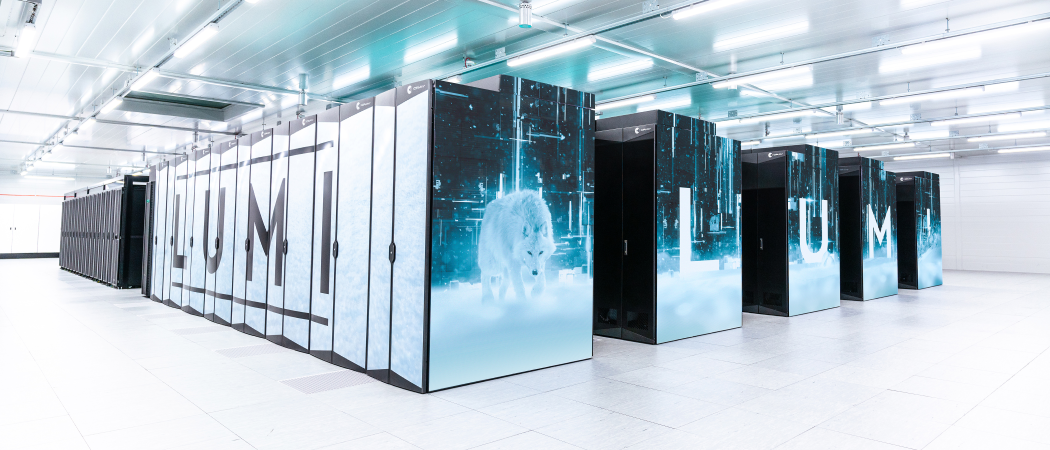How digital technology is pushing the frontiers of climate science and extreme-weather prediction.

The EU’s Destination Earth (DestinE) initiative will produce one petabyte of data per day. That is 1,000 terabytes, or the equivalent of 11,000 4K movies, which would take over 2.5 years of non-stop binge watching to view. DestinE's new Digital Twin Engine will process this data every day on supercomputers that run digital simulations to explore extreme weather events in a changing climate.
“Supercomputer demand, in particular for machine learning tasks, has substantially increased over the past six months and this will likely pick up in 2024 as more AI users come on to the machines,” says Nils Wedi, digital technology lead for DestinE at the European Centre for Medium-Range Weather Forecasts (ECMWF).
The computing resources needed for DestinE are provided by the EuroHPC Joint Undertaking, with allocations on four new supercomputing facilities, which are among the most powerful in the world (LUMI, Leonardo, Mare Nostrum 5 and MeluXina). Fully exploiting the potential of this new generation of supercomputers for complex physical Earth system models requires major efforts to adapt current codes and allow simulations to run on novel computing architectures, Wedi explains. Machine learning frameworks make this easier, but still require bespoke efforts to exploit the full potential. This is one of several tasks supported by the new Digital Twin Engine, an essential component of the DestinE system developed by ECMWF and its partners.
Overseeing the developments of the Digital Twin Engine at ECMWF, Wedi elaborates on one of the many benefits of utilising modern supercomputers splitting complex problems into thousands of computing tasks that can be processed in parallel for faster results. A user journey may start with a simple question that could turn into bespoke simulations on a supercomputer. In other cases, a user may be directed to a “digital bridge” that might easily fish the answer out of a river of data that a supercomputer is producing all the time. “The inquiry could easily involve access to other sources of information on distributed clouds without the user necessarily knowing where the information is produced”, he notes.
Meeting the needs of many different sectors
The Digital Twin Engine is helping deploy the first two “digital twins” of the Earth developed in DestinE. One of the digital twins focuses on the simulation of extreme weather-induced events on a time scale of a few days ahead, while the other targets simulations on a time scale of several decades ahead to help policymakers make better decisions in the context of climate change, as outlined in this article.
Both digital twins produce information at kilometre-scales where the impacts of extreme events and climate change are felt. “In these simulations suddenly you might encounter eddies, motions and patterns you hadn’t considered before” says Wedi. “Increased resolution comes with increased complexity—and computing needs.”
The entire DestinE system is designed to help apply machine learning techniques on digital twin data. Machine learning algorithms could potentially parse vast streams and pools of data and make sense of them much faster than any human operator. Machine learning-driven models can also help complement the simulations with the physical models, supporting the quantification of uncertainties. The Digital Twin Engine provides repeated and intense access to the high-quality data and capabilities needed for machine learning at scale.
ECMWF says the Digital Twin Engine, which is being developed in collaboration with partners across Europe, is a “first of its kind” cutting-edge, digital software environment to unlock the full potential of Destination Earth digital twin data.
Use case simulations attached to the digital twins can cover a wide range of topics, from energy to agriculture and food security, helping these sectors to act more sustainably. “Digital twin advances will enable global predictions of power generation, for example benefitting the management of the renewables market,” explains Tiago Quintino, head of development at ECMWF.
Financed under the European Union’s ambitious Green Deal, DestinE is being implemented by ECMWF, the European Space Agency and the European Organisation for the Exploitation of Meteorological Satellites EUMETSAT, in collaboration with more than 116 institutions and hundreds of experts across Europe.
“When I joined ECMWF 12 years ago, we used to produce 20 terabytes of data per day,” recalls Quintino. “With DestinE and the new information system it will unveil, the amount of data produced per day will be unprecedented."





 A unique international forum for public research organisations and companies to connect their external engagement with strategic interests around their R&D system.
A unique international forum for public research organisations and companies to connect their external engagement with strategic interests around their R&D system.